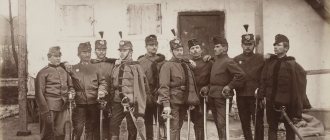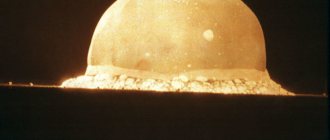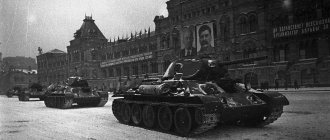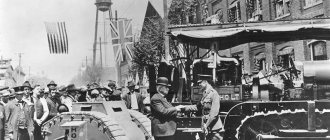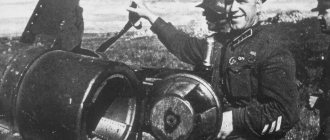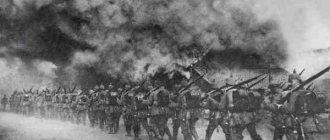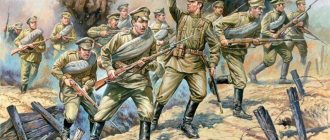Battle of Borodino. Background
Before Napoleon’s arrival in Russia, France was “lucky” to survive five anti-French coalitions, and the Russian army experienced the bitterness of two major defeats (in 1805 and 1807). In a word, Bonaparte had motives for the offensive. In addition, Alexander I did not really comply with the requirements of the continental blockade, which, of course, could not please the French.
The year was 1812. Bonaparte's Grand Army was rushing towards Moscow, the Russians were retreating. Napoleon dreamed of a general battle, but the commanders of the Russian army studiously avoided him. As for the numbers, at the start of the battle (although historians still differ on this issue), Bonaparte had from 90 to 150 thousand soldiers, Kutuzov - from 110 to 140 thousand.
The battle of Borodino lasted about twelve hours. The day before hour X, the troops of both sides carefully prepared. However, the Shevardinsky battle took place first.
Inhospitable Smolensk
Having reached Smolensk, where provisions and equipment were waiting for his army, Napoleon decided to turn the city into a main stronghold. He expected to spend the winter here, because he understood that his hungry and freezing army was clearly not ready for the long march to the west.
These plans were not destined to come true. Very soon, Napoleon received news that attempts to contain the Russian advance on his flanks - Admiral Chichagov in the south and Lieutenant General Peter Wittgenstein in the north - had failed. Food supplies in Smolensk turned out to be significantly less than expected, and the still starving army did not become more manageable. Napoleon did not risk possible encirclement in such a situation and gave the order to continue the retreat, heading towards Orsha. To prevent the story of a shortage of provisions from repeating itself, he ordered that everything that the provisions teams could collect be brought to this city in advance.
Forced to retreat through the same terrain that his troops had already covered once with a fine comb, Napoleon could not lead the Great Army gathered into a single fist. Firstly, it turned into nothing the already meager supplies of provisions that could be counted on along the way. Secondly, the frosts that struck did not make it possible to spend the night in bivouacs, and it was not possible to count on the fact that almost 60 thousand people would find shelter in small villages. And on November 12 (hereinafter dates according to the new style. - Author's note) the French began to gradually leave Smolensk.
Shevardino
Kutuzov placed the advanced detachments of Russian troops near the village of Shevardino, on the so-called Shevardinsky redoubt. About 11 thousand people under the command of Lieutenant General Gorchakov were supposed to take the enemy’s first blow.
Battle for the Shevardinsky redoubt. (wikipedia.org)
The battles for the Shevardinsky redoubt began on September 5: at first the French managed to knock out the Russian army from there, but then the reserves of two Russian divisions were able to recapture and reoccupy the redoubt.
Opponents
Under the command of Commander-in-Chief Kutuzov, the First and Second Western Armies marched under the command of M. B. Barclay de Tolly and P. I. Bagration, respectively. The number of troops was 120-140 thousand people, including 10 thousand untrained militia from Moscow and Smolensk, who were mainly used in auxiliary work.
The French army was commanded by Napoleon Bonaparte himself. His army, in addition to the French themselves, included regiments from France's vassal states - Bavaria, Spain, Prussia, Portugal, the Netherlands and others. By the time all units joined this army, its number reached 135 thousand people.
Beginning of the Battle of Borodino
On September 7, 1812, at five thirty minutes in the morning, about a hundred French guns fired in the direction of the positions of the Russian army, at this signal the French divisions moved towards Borodino. The Jaeger Regiment of the Life Guards, guarding the village, took on superior enemy forces and heroically held its position for about an hour.
Napoleon on the Borodino field. (wikipedia.org)
The Russian army managed to prepare well for the battle: for example, in the shortest possible time, the so-called Bagration flushes were erected - field fortifications designed to cover important defense points. It was on them that at six o'clock in the morning the attacks of the French divisions fell. In two hours, the French, who met fierce resistance from the rangers, were able to capture only the southern flush.
Fight for Bagrationov flushes. (wikipedia.org)
During a counterattack by three Russian cuirassier regiments, one of the most important French military leaders, Marshal Murat, was almost captured. By eleven o'clock, Napoleon launched a decisive - the eighth according to Russian historians - attack on Bagration's flushes: the emperor sent 45 thousand infantry and 400 guns there. In hand-to-hand combat that lasted about an hour, the Russian army pushed back the enemy, but only until General Bagration was wounded. The news immediately spread through the ranks, the demoralized Russian troops retreated, the flashes, having fulfilled their main function of containing the enemy, were abandoned. The direction of the main attack of the French shifted to the Raevsky battery.
Russian army positions
The location of the Russian army on the Borodino field is still being debated. Why did Kutuzov choose this particular location, because according to some researchers, the troops could have been positioned much more advantageously. The participants in the battle wrote about this without delay. For example, General Levin-August-Gottlieb (Leonty Leontyevich) Bennigsen believed that the right flank should have been “rested on the village of Gorki and all other troops moved to support the left wing.” In those days he held the post of Chief of the General Staff.
Here again it is necessary to remember that there was no consensus among the generals on how to fight against Napoleon. Bennigsen even drew up a battle plan. For example, the day before he went to Tuchkov’s corps with the order to immediately move out of the Utitsky forest into an open place and take positions from Bagration’s left flank. As a result, Tuchkov's corps and the Moscow militia suffered heavy losses.
Barclay de Tolly, according to his memoirs, proposed that at night the right flank of the 1st Army should be withdrawn to the heights of Gorki, and the left should hold Semyonovka. And the 2nd Army occupied the location of the 3rd Corps. It should have turned out that the battle order would have remained the same, the reserves were in one place, and “not scattered and, perhaps, would have decided the battle.” And Prince Bagration could strike at the right flank of the French army. It can be added that the memoirs were written after the battle. Adding to the controversy are the French assertions that, in their words, the Russian right flank “was as impregnable as it was harmless.”
What is most criticized is that 4 corps and Platov’s Cossacks were stationed on the Borodino-Maslovo line. That is, they stood where no attacks from the French were planned. They also add that Maslovsky flashes, well prepared and armed with heavy artillery, were out of the battle.
The fact is that the Shevardinsky redoubt was not located on the front line, as is often stated, but was part of a united front from Maslov to Shevardin. Natural barriers were used for its defense. The main task that had to be solved was to reliably block the New Smolensk road in the event of the enemy breaking through the front. They also wanted to force the French to attack from the northwestern direction, across the Kolocha River. Forcing it would have forced the French to put in a lot of effort and waste time. But even in this case, the value of Maslovsky flushes was small.
Kutuzov had already encountered Bonaparte, so he knew all of his strengths and based on this he drew up a disposition, trying to predict all options for the development of the battle, even the most negative ones.
If the French had broken through the defenses, it would have been the Maslovsky flushes that would have prevented them from developing a further offensive and capturing the New Smolensk Road. And if the Russian troops had not managed to retreat towards Mozhaisk, then it would have been a disaster. So this fortified unit with heavy artillery solved an important task - to insure the Russian troops if everything did not go according to plan.
Another question is asked: why did Kutuzov deploy heavy artillery to the north? But if you look at a map of the area, or rather, at the river, it becomes clear that Mikhail Illarionovich feared that near the villages of Aksinino and Rakhmanovo the enemy would ford the Moscow River. And the Gzhatsky trade route passed nearby; it crossed the Marfin Ford, and along it the French could easily reach the rear of the Russian army. As we see, Kutuzov calculated all conceivable options. All that remained was to wait to see what Napoleon would do.
Let us note that this is all well known now, how Napoleon attacked, and then Kutuzov was faced with a task with many unknowns. He did not know for sure that the French were advancing in two columns along both Smolensk roads. But the Beauharnais corps could have marched along the Gzhatsky tract, in which case Napoleon’s army could have crossed the Moscow River far from the Russian troops and bypassed from the rear. And the battery on the Maslovsky Heights could fire at the Gzhatsky tract, this could give Kutuzov time to regroup his troops.
Conclusion, Maslov’s flashes are not the tyranny of an out-of-mind commander-in-chief, but a conscious, clearly thought-out element of the plan of an experienced commander-in-chief, which, in the event of a breakthrough of the defense line, would make it possible to hold back the offensive with minimal forces and gain time for the necessary maneuvers.
The Shevardinsky redoubt occupied the highest point above the field of the upcoming famous battle. To the south there were higher hills, but they were far from the center of the battle and overgrown with forest and bushes; there was no time, energy or sense to clear them. So the Shevardinsky redoubt found itself at a commanding height above the field, as a forward strong point. A battery of heavy guns was placed there; this would have Napoleon deploying forces north of the village of Borodino and would force him to choose: advance from the march or withdraw troops from the artillery fire zone. Kutuzov’s headquarters hoped that the French would attack on the Loginovo-Bezzubovo line and north of Valuev, that is, cross the Kolocha River, or try to make a maneuver to bypass the location of Russian troops to the north. The leader of the “invincible army” did not like this situation. Napoleon tried to play by his own rules.
In one of his reports to the Emperor, Kutuzov wrote:
“The redoubt we built on the 24th, as well as the rangers who settled in ditches and bushes on the right bank of the Kolocha River and occupied the villages of Fomkina, Aleksin and Dronin, made it very difficult for the enemy to approach along the high road...”
Kutuzov calculated everything he could.
Disposition of Russian troops
The defense line stretched for 8 km. In the south it began near the village of Utitsa, in the north - near the village of Maslovo.
1. Right flank.
The right flank covered about 5 km, the troops took up positions along the high and steep bank of the Koloch River. The soldiers reliably blocked the New Smolensk road, where Napoleon was trying to break through. In the event of an unfavorable outcome of the battle, Kutuzov intended to withdraw troops along it. It was difficult for the French to outflank the position; the position was covered on either side by dense forests, and the terrain was hilly, cut by rivers and streams. The soldiers erected several fortifications here: Maslovsky flushes, gun positions and abatis.
2. Center.
The main fortified unit in the center of defense was the Kurgan Heights battery (Raevsky Battery), and the French called this fortification structure the Great Redoubt.
3. Left flank.
On the left, the area was not so wooded, so it was necessary to urgently erect “fortifications with the help of art,” that is, field fortifications. Semenovsky (Bagrationovsky) flushes were built here. In front of the flushes, one and a half kilometers away, the Shevardinsky redoubt was erected. Unfortunately, by the beginning of the battle they were not fully completed.
This disposition of the Russian troops confronted Napoleon with a difficult choice.
Battery Raevsky
In the center of the position occupied by the Russian army there was a high mound, from which the entire area was clearly visible. It was there that a battery of 18 guns was installed under the command of Lieutenant General Raevsky. When the attack on the battery began at nine o'clock in the morning, all the soldiers defending it were transferred to defend the flushes. However, this did not stop the artillerymen from fighting back with heavy fire from their guns. On the second attempt, the French were able to break into the redoubt, after which the Russian regiments went into bayonet warfare - the French were knocked out and the general was captured.
Artillerymen on the Raevsky battery. (wikipedia.org)
Napoleon's original plan to quickly break through the Russian defenses was already meaningless. During the next attack on Raevsky’s battery, which lasted several hours, the French noticed Russian Cossacks in their rear.
Results
As a result of the actions of the French, the Semenov flushes (also called Bagrationovskys) came to the fore, while the Maslovsky ones turned out to be useless. The importance of the Old Smolensk Road has sharply increased. Now, with the help of this route, the French were able to carry out an enveloping maneuver. The center of gravity of the upcoming Borodino events has shifted further to the south. Napoleon had the commanding heights in his hands, which he gained thanks to his risky attack. The French emperor no longer needed to break through the Russian fortified line, which relied on Kolocha and was distinguished by natural barriers in the form of inaccessible river banks. Thus, Napoleon leveled the position and, in a certain sense, outplayed Kutuzov. The further fate of the Battle of Borodino depended on the skill of the commanders on the battlefield.
It is believed that during the capture of the Shevardinsky redoubt, the French lost about 4-5 thousand people killed and wounded, while Russian losses amounted to 6-7 thousand. Such great damage is explained by the significant predominance of enemy artillery and the numerical superiority of the enemy. Russian troops suffered significant losses due to flanking and crossfire.
Cossack raid of Platov and Uvarov
Uvarov's cavalry corps and Platov's Cossacks, by decision of Kutuzov, moved to the rear of the enemy. Quickly crossing the river, they delivered an unexpected and crushing blow to the positions of General Ornano's troops. The troops that stormed Raevsky's battery were transferred to battle with the Cossacks.
Cossack raid behind French lines. (wikipedia.org)
At four o'clock in the afternoon, having caused a commotion in the French camp, Uvarov and Platov returned to their army: their main goal was achieved - the French army weakened the offensive and gave the Russians a respite, during which Kutuzov's army managed to regroup.
“It’s not for nothing that all of Russia remembers...”
Having driven the Cossacks out of their positions, the French army resumed its attack on Raevsky’s battery. 150 guns fired cross-fire at the battery - literally every meter of land was plowed with shells, but Raevsky’s artillerymen did not give up. The cavalry corps of General Caulaincourt was thrown into the attack on the “grave of the French cavalry,” as the French called the battery, while at the same time the corps of the Viceroy of Italy Beauharnais was advancing from the flank. A bloody battle ensued at the battery, during which Caulaincourt was killed and the Russian general Likhachev was captured.
Death of General Caulaincourt. (wikipedia.org)
Raevsky's battery fell, however, having assessed the location of the Russian army and the losses suffered, Napoleon came to the conclusion that the Russians were still firmly holding their positions. The emperor rejected the proposal to bring the legendary imperial guard into battle - the battle near the village of Borodino began to subside as the French gradually stopped their offensive.
Company's actions
The enemy was moving along the high road. Three enemy columns remained at the same height. At two o'clock in the afternoon they crossed Kolocha and headed for the Shevardinsky redoubt. The battle of that day was briefly described by many eyewitnesses, including Alexander Mikhailovsky-Danilevsky. He noted that Konovitsyn was forced to retreat to Borodino. After this, rearguard regiments began to be part of the corps. The Russian army, arranged in battle formation, appeared before the enemy. Access to it was blocked by the Shevardinsky redoubt. The history of that battle has attracted the attention of many historians...
Kompan skillfully took advantage of the features of the local terrain. For what purpose was the Shevardinsky redoubt built? To prevent the French from reforming and attacking the main Russian army. To facilitate the capture of the fortification, Kompan used the occupied hill as a platform for his cannons. The guns caused great damage by firing at the redoubt and infantry shelter.
The end of the Battle of Borodino
The sluggish artillery fire continued until seven o'clock in the evening. At the captured positions, Napoleon, to his indignation, found neither prisoners nor abandoned artillery pieces. The French simply abandoned the positions they had won with such difficulty, returning to their original location.
The end of the Battle of Borodino. (wikipedia.org)
The rest of the Russian army began to intensively prepare for the next day of battle, but at midnight Kutuzov’s order came to leave their positions and move towards Mozhaisk. Thus, without identifying a final winner, one of the greatest battles in history ended.
The battle
The first shootout lasted about an hour. Having held out for an unexpectedly long time, the Russian flankers and rangers retreated. Just at this time, the enemy forces, under the personal command of Napoleon, marched in columns straight towards the fortifications. They were preceded by the fire of numerous enemy artillery.
There was an excessive numerical superiority of the French. It forced Gorchakov to immediately introduce reserve grenadiers into action. However, it took them a while to get there. While they were approaching, cannonballs, grapeshot, grenades and bullets bombarded the defending troops and the Shevardinsky redoubt. “What is this if not victory?!” – thought the French, but their triumph was short-lived. As soon as they began to take possession of the redoubt, the reserve grenadiers entered the battle. Their approach was truly impressive. Priests dressed in vestments walked ahead of the grenadiers. With crosses in their hands, they strengthened the morale of the soldiers and inspired them to go on the attack.
The regiments that arrived to help the redoubt reached the battery. The enemy was driven back. In the heat of battle, hand-to-hand combat began. The opponents took turns overthrowing each other and seizing the initiative, but neither side could gain the advantage necessary for final victory. It was getting dark, and Shevardino, the redoubt and the forest located on the left wing remained with the Russians.

